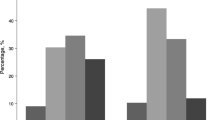Abstract.
Object. The effect of altitude on lung func- tion was evaluated in 21 healthy volunteers at 171 m and at 1580 m above sea level. Method. Results were obtained using an open spirometry system. Design. The parameters analyzed were forced vital capacity (FVC), forced expiration volume after 1 s (FEV1), relative 1-s capacity (FEV1/FVC), mean expiratory flows at 75%, 50% and 25% of FVC (MEF75, MEF50, MEF25), and maximal expiratory flow (peak flow, PEF). Results. MEF75 and MEF50 revealed a positive correlation with altitude, with mean rises of 15% and 11%, respectively. The difference was statistically significant for MEF75 (P=0.0009) and MEF50 (P=0.0001), whereas the other parameters revealed no significant difference. Conclusion. Altitude could be a variable influencing spirometric measurements.
Similar content being viewed by others
Author information
Authors and Affiliations
Additional information
Received: 22 December 1995 / Accepted: 19 February 1996
Rights and permissions
About this article
Cite this article
Wolf, C., Staudenherz, A., Röggla, G. et al. Potential impact of altitude on lung function. Int Arch Occup Environ Health 69, 106–108 (1996). https://doi.org/10.1007/s004200050123
Issue Date:
DOI: https://doi.org/10.1007/s004200050123




